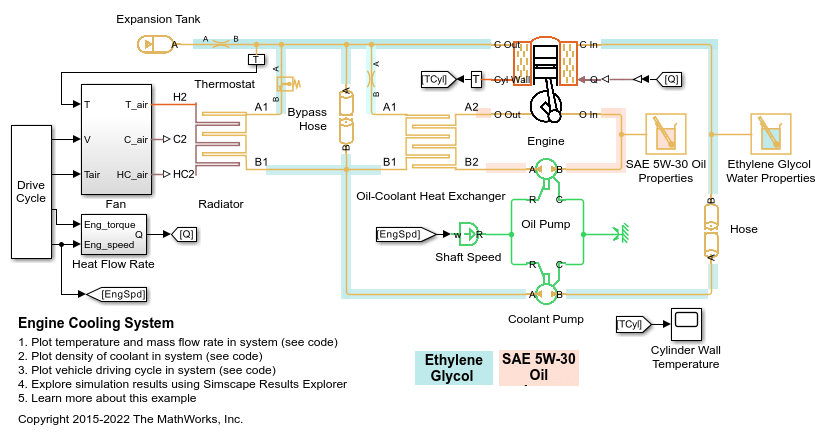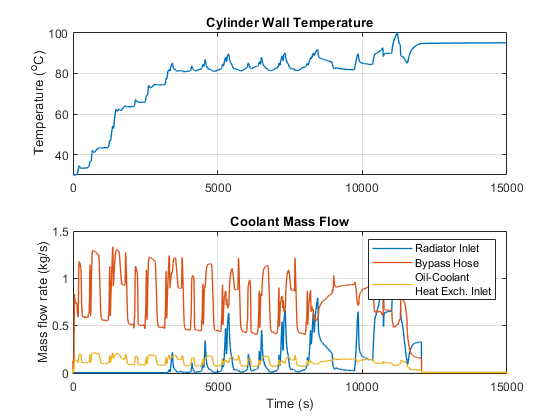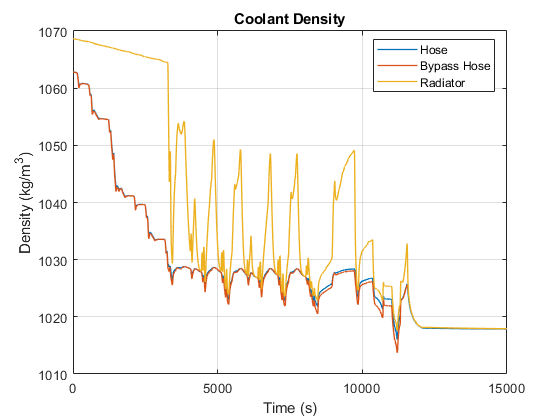Engine Cooling System
This example shows how to model an engine cooling system with an oil cooling circuit using Simscape™ Fluids™ Thermal Liquid blocks. The system includes a coolant circuit and an oil cooling circuit. A fixed-displacement pump drives coolant through the cooling circuit. The main portion of heat from the engine is absorbed by the coolant and dissipated through the radiator. The system temperature is regulated by the thermostat, which diverts flow to the radiator only when the temperature is above a threshold. The oil cooling circuit also absorbs some of the heat from the engine. The heat added to the oil is transferred to the coolant by the oil-coolant heat exchanger. The Radiator is the E-NTU Heat Exchanger (TL) block with the air-side flow controlled by physical signal inputs. The oil-coolant heat exchanger is the E-NTU Heat Exchanger (TL-TL) block. Both coolant pump and oil pump are driven by the engine speed.
Model

Engine Subsystem
The thermal power generated by the engine is calculated as a function of the instantaneous engine speed and the engine torque. This power is separated in two parts going to the coolant and the oil circuit. It is assumed that 50% of the amount of heat rejected from the engine is added to the coolant and 20% of the heat rejected from the engine is added to the oil.

Heat Flow Rate in Engine Subsystem

Fan Subsystem

Fan Unit Subsystem
The cooling air speed in the radiator is modeled with a 2D lookup table as a function of instantaneous vehicle speed and the fan controller signal.

Fan Control Subsystem
The fan controller unit includes two control levels. The primary level operates at coolant temperatures higher than the primary control target temperature. Once the coolant temperature exceeds a temperature threshold, the secondary level is activated.

2-Level Fan Controller Subsystem

Air Subsystem

Driving Cycle Subsystem
The real vehicle driving cycle is presented based on the instantaneous vehicle speed, the engine speed, and the engine torque inputs.

Shaft Speed Subsystem

Simulation Results from Scopes

Simulation Results from Simscape Logging
These plots show the effect of opening the thermostat in the engine cooling system. The temperature of the engine block climbs steadily until the thermostat opens. At that point, the flow of coolant through the radiator climbs sharply and the flow of coolant through the bypass hose decreases. Because coolant passing through the radiator releases heat to the atmosphere, the engine block temperature rises more slowly.

This plot shows the density of the coolant at different locations in the cooling system over time. The density of the coolant varies throughout the network based on the local temperature and pressure.

These plots show the instantaneous vehicle speed, engine speed and torque input profiles. The vehicle starts from rest accelerating to near its maximum speed. Subsequently, the vehicle decelerates till it fully stops.
